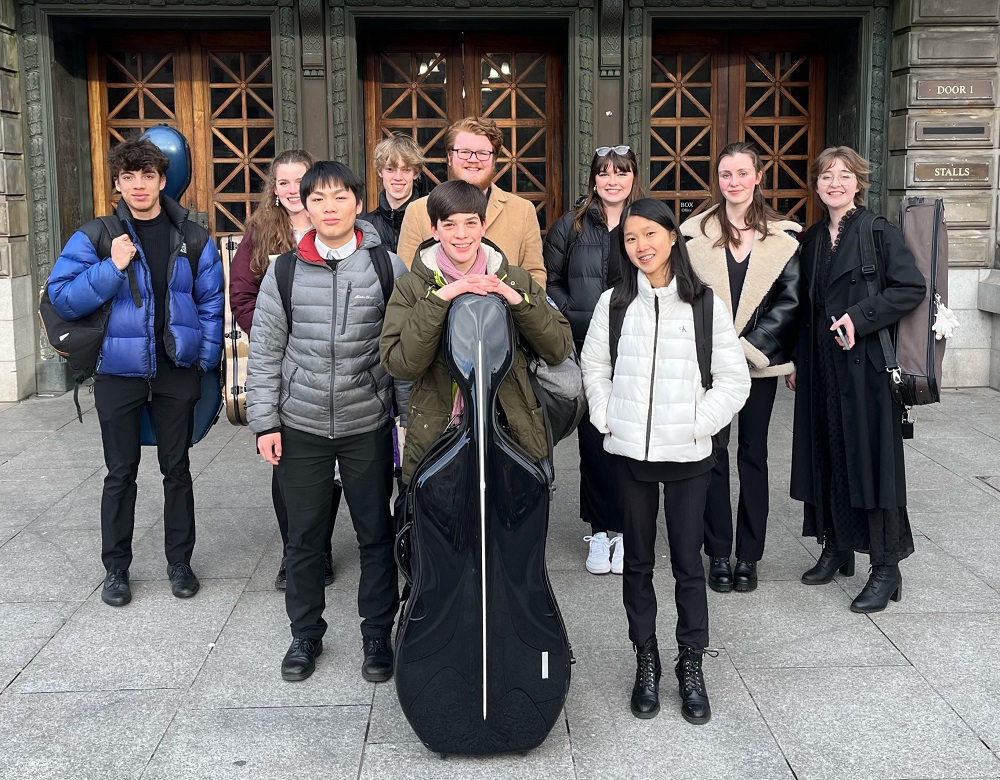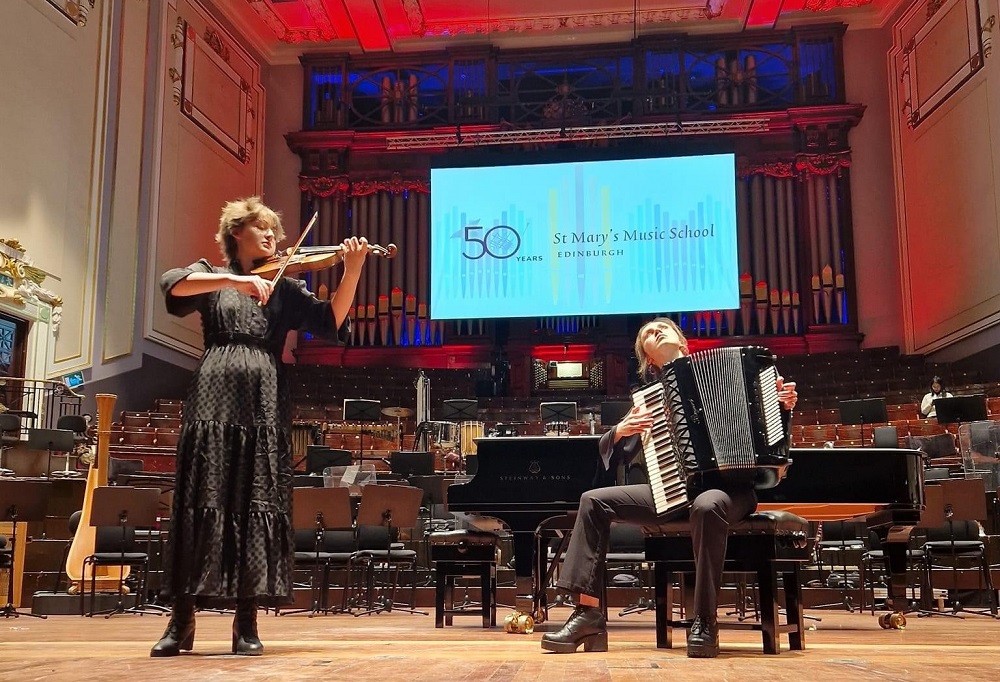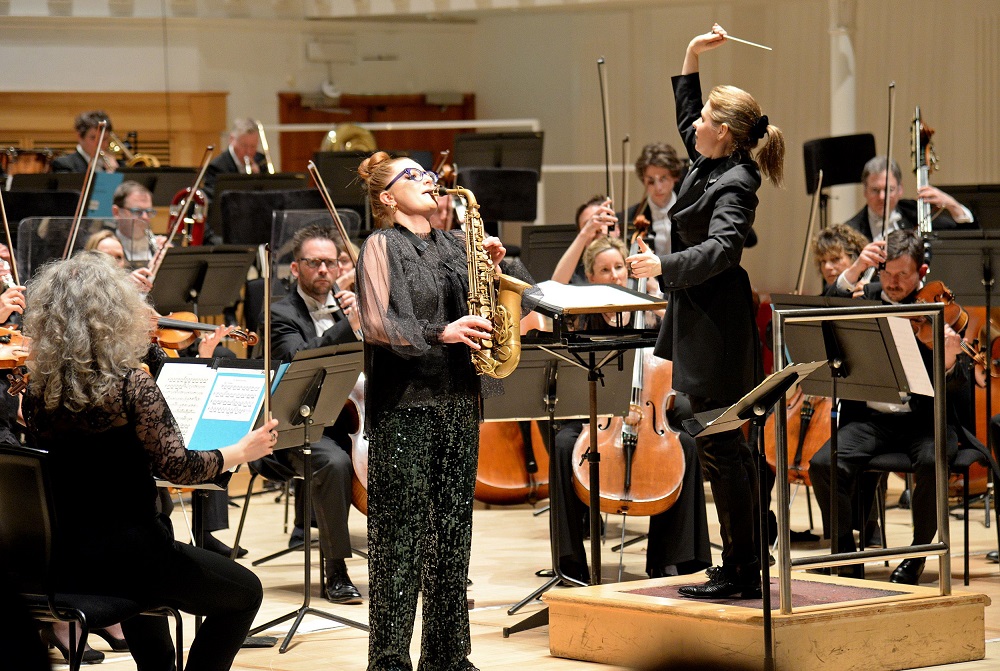St Mary’s Music School, RSNO, New, Usher Hall, Edinburgh review - a cornucopia of delights | reviews, news & interviews
St Mary’s Music School, RSNO, New, Usher Hall, Edinburgh review - a cornucopia of delights
St Mary’s Music School, RSNO, New, Usher Hall, Edinburgh review - a cornucopia of delights
From talented young musicians to a concerto for artist and orchestra
This evening brought to mind those marathon 19th century concerts when Beethoven would unleash a handful of new symphonies and a couple of piano concertos on an unsuspecting public.
The programme in Edinburgh's Usher Hall began at 6pm with a smorgasbord of delightful show pieces by the pupils of St Mary’s Music School, celebrating its 50th anniversary, and continued with a full programme from the Royal Scottish National Orchestra, effortlessly squeezing in two diminutive saxophone concertos before the interval and Musorgsky’s Pictures at an Exhibition after – the latter embellished by a real live artist quite literally painting an accompaniment to the music. One slightly dazed member of the audience confessed to me that there had been almost too much innovation and creativity for one evening.  But to begin at the beginning, the RSNO offered St Mary’s, Scotland’s only specialist music school, a chance to take the main stage of the Usher Hall for a 45 minute showcase recital before the orchestra’s traditional Friday night slot. They accepted eagerly, notwithstanding some reported anxious moments backstage at the prospect of playing to this vast auditorium. Senior pupil Carlo Massimo broke the ice effectively with “Dieu parmi nous” from La Nativité du Seigneur by Messaien, a piece that allowed the Usher Hall organ to show off its chameleon-like capabilities – here sounding every bit like the French cathedral instruments for which this music was intended. This short extract proved not only Massimo’s musicianship but also, through the use of multiple registrations, his technical prowess. Much work had clearly gone into finding the right combination of stops.
But to begin at the beginning, the RSNO offered St Mary’s, Scotland’s only specialist music school, a chance to take the main stage of the Usher Hall for a 45 minute showcase recital before the orchestra’s traditional Friday night slot. They accepted eagerly, notwithstanding some reported anxious moments backstage at the prospect of playing to this vast auditorium. Senior pupil Carlo Massimo broke the ice effectively with “Dieu parmi nous” from La Nativité du Seigneur by Messaien, a piece that allowed the Usher Hall organ to show off its chameleon-like capabilities – here sounding every bit like the French cathedral instruments for which this music was intended. This short extract proved not only Massimo’s musicianship but also, through the use of multiple registrations, his technical prowess. Much work had clearly gone into finding the right combination of stops.
Of the four pieces which followed, including a slice of Schubert’s “Death and the Maiden” and a Tchaikovsky Nocturne for cello, those which stood out were the Notturno e Danza by Rautavaara in which Amias Kroeger’s violin hovered over a wonderfully accomplished piano accompaniment by Alexander Kwon, and the final piece, Shine you no more, a folksy piece by Rune Sorenson arranged for violin and accordion. This laid back performance by Hester Parkin and Kirsty Grant (pictured below) showed two musicians utterly at ease with each other and the considerable demands of the music. 
Star Cumbrian saxophonist Jess Gillam (pictured below with New and the RSNO) joined the orchestra for the next two pieces, firstly Glazunov’s 1930s Saxophone Concerto, followed by Milhaud’s Scaramouche, a concerto in all but name from the same era. Gillam gives her all to everything she plays, no exceptions here, but the Glazunov is a weary, slightly fey piece whose geniality continually swerves away from popularity. As such it was easily eclipsed by the much more engaging Scaramouche, particularly the famously catchy “Brazileira Mouvement de Samba”. If the Glazunov showed off Gillam’s poise, refinement and patience, Milhaud’s frenetic scales and rhythmic complexity offered a more conventional outlet for breath-taking high wire virtuosity.  But if the audience took one memory home at the end of the evening, it could only have been the extraordinary sight of the artist James Mayhew painting his interpretation of Musorgsky’s Pictures in real time as the music was being performed. Using quite a small canvas about A3 size, the images were filmed and projected onto a large screen above the organ console. Not only did he faithfully reproduce likenesses of the paintings, but he did it with brush strokes more on less in time to the music, and at the same time responding to musical cues – such as painting in a church bell seconds before the same instrument is heard in the orchestra in “The Great Gate of Kiev”. The result was effectively a Concerto for Artist (seldom could any artist expect to encounter such a storm of appreciative applause for producing half a dozen sketches), but bizarrely a concerto where a totally silent instrument almost completely masked the considerable effort of a large orchestra. I for one regretted that the painting was so compelling that I paid little attention to the music, except as a backcloth.
But if the audience took one memory home at the end of the evening, it could only have been the extraordinary sight of the artist James Mayhew painting his interpretation of Musorgsky’s Pictures in real time as the music was being performed. Using quite a small canvas about A3 size, the images were filmed and projected onto a large screen above the organ console. Not only did he faithfully reproduce likenesses of the paintings, but he did it with brush strokes more on less in time to the music, and at the same time responding to musical cues – such as painting in a church bell seconds before the same instrument is heard in the orchestra in “The Great Gate of Kiev”. The result was effectively a Concerto for Artist (seldom could any artist expect to encounter such a storm of appreciative applause for producing half a dozen sketches), but bizarrely a concerto where a totally silent instrument almost completely masked the considerable effort of a large orchestra. I for one regretted that the painting was so compelling that I paid little attention to the music, except as a backcloth.
I noted that the RSNO have a video games music night coming up. Innovation is in the air. Friday’s adventurous programme drew a large crowd. So did an utterly conventional Brahms and Beethoven programme a few weeks ago. Whatever it takes, if it helps keep live music alive.
rating
Explore topics
Share this article
The future of Arts Journalism
You can stop theartsdesk.com closing!
We urgently need financing to survive. Our fundraising drive has thus far raised £49,000 but we need to reach £100,000 or we will be forced to close. Please contribute here: https://gofund.me/c3f6033d
And if you can forward this information to anyone who might assist, we’d be grateful.

Subscribe to theartsdesk.com
Thank you for continuing to read our work on theartsdesk.com. For unlimited access to every article in its entirety, including our archive of more than 15,000 pieces, we're asking for £5 per month or £40 per year. We feel it's a very good deal, and hope you do too.
To take a subscription now simply click here.
And if you're looking for that extra gift for a friend or family member, why not treat them to a theartsdesk.com gift subscription?
more Classical music
 Kaploukhii, Greenwich Chamber Orchestra, Cutts, St James's Piccadilly review - promising young pianist
A robust and assertive Beethoven concerto suggests a player to follow
Kaploukhii, Greenwich Chamber Orchestra, Cutts, St James's Piccadilly review - promising young pianist
A robust and assertive Beethoven concerto suggests a player to follow
 Robin Holloway: Music's Odyssey review - lessons in composition
Broad and idiosyncratic survey of classical music is insightful but slightly indigestible
Robin Holloway: Music's Odyssey review - lessons in composition
Broad and idiosyncratic survey of classical music is insightful but slightly indigestible
 Classical CDs: Wolf-pelts, clowns and social realism
British ballet scores, 19th century cello works and contemporary piano etudes
Classical CDs: Wolf-pelts, clowns and social realism
British ballet scores, 19th century cello works and contemporary piano etudes
 Bizet in 150th anniversary year: rich and rare French offerings from Palazzetto Bru Zane
Specialists in French romantic music unveil a treasure trove both live and on disc
Bizet in 150th anniversary year: rich and rare French offerings from Palazzetto Bru Zane
Specialists in French romantic music unveil a treasure trove both live and on disc
 Scottish Chamber Orchestra, Ibragimova, Queen’s Hall, Edinburgh review - rarities, novelties and drumrolls
A pity the SCO didn't pick a better showcase for a shining guest artist
Scottish Chamber Orchestra, Ibragimova, Queen’s Hall, Edinburgh review - rarities, novelties and drumrolls
A pity the SCO didn't pick a better showcase for a shining guest artist
 Kilsby, Parkes, Sinfonia of London, Wilson, Barbican review - string things zing and sing in expert hands
British masterpieces for strings plus other-worldly tenor and horn - and a muscular rarity
Kilsby, Parkes, Sinfonia of London, Wilson, Barbican review - string things zing and sing in expert hands
British masterpieces for strings plus other-worldly tenor and horn - and a muscular rarity
 From Historical to Hip-Hop, Classically Black Music Festival, Kings Place review - a cluster of impressive stars for the future
From quasi-Mozartian elegance to the gritty humour of a kitchen inspection
From Historical to Hip-Hop, Classically Black Music Festival, Kings Place review - a cluster of impressive stars for the future
From quasi-Mozartian elegance to the gritty humour of a kitchen inspection
 Shibe, LSO, Adès, Barbican review - gaudy and glorious new music alongside serene Sibelius
Adès’s passion makes persuasive case for the music he loves, both new and old
Shibe, LSO, Adès, Barbican review - gaudy and glorious new music alongside serene Sibelius
Adès’s passion makes persuasive case for the music he loves, both new and old
 Anja Mittermüller, Richard Fu, Wigmore Hall review - a glorious hall debut
The Austrian mezzo shines - at the age of 22
Anja Mittermüller, Richard Fu, Wigmore Hall review - a glorious hall debut
The Austrian mezzo shines - at the age of 22
 First Person: clarinettist Oliver Pashley on the new horizons of The Hermes Experiment's latest album
Compositions by members of this unusual quartet feature for the first time
First Person: clarinettist Oliver Pashley on the new horizons of The Hermes Experiment's latest album
Compositions by members of this unusual quartet feature for the first time
 Gesualdo Passione, Les Arts Florissants, Amala Dior Company, Barbican review - inspired collaboration excavates the music's humanity
At times it was like watching an anarchic religious procession
Gesualdo Passione, Les Arts Florissants, Amala Dior Company, Barbican review - inspired collaboration excavates the music's humanity
At times it was like watching an anarchic religious procession

Add comment